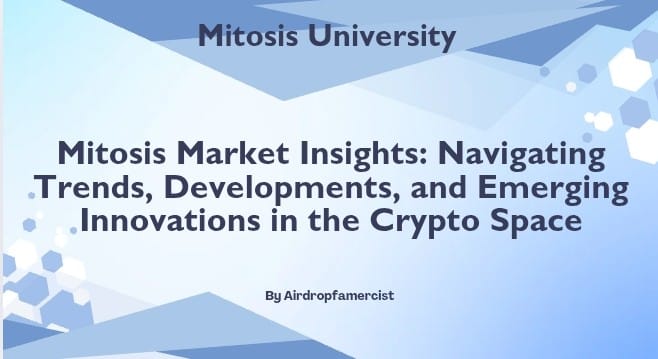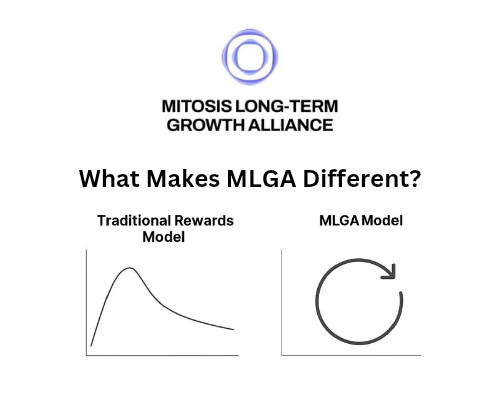Mitosis Market Insights: Navigating Trends, Developments, and Emerging Innovations in the Crypto Space

The cryptocurrency landscape in 2025 is a dynamic arena, characterized by rapid innovation, shifting regulatory frameworks, and evolving user demands. As a Layer 1 (L1) blockchain focused on Ecosystem-Owned Liquidity (EOL), Mitosis is uniquely positioned to capitalize on these trends while addressing challenges in decentralized finance (DeFi).
This article explores the broader crypto market trends, recent developments, and emerging innovations that could shape Mitosis’s ecosystem, offering insights into its potential trajectory.
Trends in the Broader Crypto Space
- Rise of Modular Blockchains and Interoperability: The crypto industry is increasingly embracing modular blockchain architectures, where specialized layers handle specific functions like execution, settlement, or data availability. This shift, driven by projects like Celestia and EigenLayer, allows for greater scalability and customization. Interoperability protocols are also gaining traction, enabling seamless asset and data transfers across chains.
For Mitosis, this trend aligns perfectly with its mission to unify liquidity across multiple blockchains, reducing fragmentation and enhancing capital efficiency.
However, interoperability introduces complexity. Cross-chain bridges, while essential, have historically been vulnerable to exploits, with over $2 billion lost to bridge hacks since 2020. Mitosis’s focus on secure, audited smart contracts (e.g., Mitosis Vault audited by Secure3 and Omniscia) positions it to mitigate these risks, but ongoing vigilance is critical.
- Stablecoin Dominance and Real-World Asset (RWA) Tokenization: Stablecoins now account for over 60% of illicit transaction volume and a significant share of legitimate DeFi activity, reflecting their role as a stable store of value and medium of exchange. Simultaneously, the tokenization of real-world assets—such as real estate, bonds, and commodities—is gaining momentum, with projections estimating a $10 trillion market by 2030. These trends underscore the demand for liquid, composable assets, which Mitosis addresses through its miAssets and maAssets, enabling users to tokenize liquidity positions and leverage them across DeFi protocols.
Yet, regulatory scrutiny of stablecoins is intensifying. Jurisdictions like the EU and Singapore are implementing stricter guidelines, which could impact Mitosis’s ability to integrate stablecoin liquidity pools. A proactive compliance strategy will be essential to navigate this landscape.
3. AI and DeFi Convergence: The integration of artificial intelligence (AI) into crypto is accelerating, with AI tokens like Fetch.ai seeing a market cap surge from $2.7 billion in 2023 to over $39 billion in 2025. In DeFi, AI is being used to optimize yield farming, predict market trends, and enhance governance.
Mitosis could leverage AI to refine its liquidity allocation algorithms, ensuring optimal distribution of EOL across chains. However, the computational costs and ethical concerns around AI integration require careful consideration.
- Growing Retail and Institutional Adoption: Crypto adoption is surging, with 28% of U.S. adults (approximately 65 million people) owning cryptocurrencies in 2025, nearly double the figure from 2021. Institutional interest is also rising, fueled by Bitcoin and Ethereum ETF approvals and supportive policies in some regions.
This influx of capital demands robust DeFi infrastructure, which Mitosis supports through its scalable liquidity protocol. Yet, volatility remains a concern—Bitcoin’s 2024 rally saw prices hit all-time highs, but corrections are frequent, requiring Mitosis to ensure its ecosystem remains resilient to market swings.
- Regulatory Evolution and Uncertainty: Global regulatory frameworks are evolving unevenly. While countries like El Salvador embrace crypto, others, including the U.S., remain cautious, with no plans for a Central Bank Digital Currency (CBDC) due to privacy and financial stability concerns.
Mitosis, operating globally, must navigate this patchwork of regulations. Its governance model, which empowers liquidity providers to influence decisions, could help align with community-driven compliance, but regulatory clarity will be a key determinant of its growth.
Developments Shaping the Crypto Landscape
- Liquidity Fragmentation Solutions: Liquidity fragmentation across blockchains remains a core challenge in DeFi. Mitosis’s EOL model addresses this by pooling liquidity into vaults, allowing users to deposit assets (e.g., weETH) and receive miAssets (e.g., miweETH) that grant voting rights and yield opportunities. The protocol’s $80 million Total Value Locked (TVL) in just three months since launch highlights its traction. Recent partnerships with Ether.fi, Symbiotic, and Hyperlane further bolster its cross-chain capabilities.
Competitors like Uniswap and Curve are also innovating in liquidity aggregation. Mitosis’s edge lies in its community governance, which empowers retail users to replicate institutional-grade liquidity strategies—a feature that could differentiate it in a crowded market.
- Airdrop Campaigns and User Engagement: Mitosis’s Expedition campaigns, rewarding users with MITO Points for holding miAssets, have driven significant engagement, attracting over 200,000 participants in its beta phase. These campaigns align with a broader trend of gamified incentives in DeFi, where projects use airdrops to bootstrap communities. The upcoming “Game of MITO” testnet, with 70% of testnet tokens transferable to the mainnet, signals Mitosis’s commitment to rewarding early adopters.
That said, airdrop fatigue is a risk. Users may chase short-term rewards without long-term commitment, potentially destabilizing liquidity pools. Mitosis’s Community Redistribution mechanism, which penalizes early withdrawals, mitigates this by incentivizing sustained participation.
- Security Enhancements; Security remains paramount in DeFi, with 2024 seeing $40.9 billion in illicit crypto transactions, though down from prior years. Mitosis’s use of restaked ETH for cross-chain validation and a trusted validator set for its Proof-of-Stake (PoS) chain demonstrates a proactive approach. Still, no protocol is immune to smart contract risks, and Mitosis’s reliance on audited vaults must be complemented by continuous monitoring and stress testing.
Emerging Innovations Influencing Mitosis’s Ecosystem
- Programmable Liquidity and miAsset Ecosystem: Mitosis’s flagship innovation is its programmable liquidity framework, where miAssets and maAssets transform static deposits into dynamic, yield-generating instruments. Users can deposit once and earn rewards across multiple protocols, enhancing capital efficiency. This could evolve further with innovations like dynamic rebalancing, where miAssets automatically adjust to optimize yields based on market conditions. Integrating with zero-knowledge proofs (ZKPs) could also enable private liquidity provision, appealing to privacy-conscious users.
- Cross-Chain Messaging and Hyperlane Integration: Mitosis’s partnership with Hyperlane for cross-chain messaging enables secure, scalable communication between blockchains. Emerging innovations in this space, such as Chain Abstraction, could allow Mitosis to abstract away chain-specific complexities, letting users interact with DeFi as if on a single network. This would amplify Mitosis’s value proposition, making liquidity provision seamless across ecosystems like Ethereum, Arbitrum, and Solana.
- Decentralized Governance 2.0: Mitosis’s EOL model empowers users to vote on liquidity allocation, a form of decentralized governance that could evolve with innovations like quadratic voting or reputation-based systems. These mechanisms could ensure fairer participation, preventing whale dominance while rewarding active contributors. Integrating soulbound tokens for governance roles (e.g., Sensei, Mitosis OG) could further tie rewards to community impact, strengthening ecosystem loyalty.
- Restaking and Liquid Staking Derivatives: The rise of liquid restaking tokens (LRTs), as seen with partners like Ether.fi, is reshaping DeFi. Mitosis’s support for LRTs like weETH and uniETH allows users to stake assets while retaining liquidity, a trend likely to grow as restaking protocols mature. Innovations like auto-compounding restaking or cross-chain restaking pools could enhance Mitosis’s offerings, attracting more TVL
- AI-Driven Liquidity Optimization While not yet implemented, AI-driven tools could revolutionize Mitosis’s ecosystem by predicting optimal liquidity allocation, detecting anomalies in vault activity, or personalizing user strategies. For instance, an AI model could analyze cross-chain yield opportunities in real-time, directing EOL to maximize returns. Given the $39 billion AI token market, this integration could be a game-changer, though it requires balancing cost and complexity.
Challenges and Considerations
Despite its potential, Mitosis faces hurdles. Smart contract vulnerabilities, while mitigated by audits, remain a risk, as seen in past DeFi exploits. Regulatory uncertainty could restrict cross-border operations, particularly for stablecoin integrations.
Additionally, competition from established players like Uniswap and emerging protocols demands continuous innovation to maintain market share. Mitosis’s community-driven approach and focus on retail empowerment are strengths, but scaling governance without compromising efficiency will be critical.
Conclusion
Mitosis stands at the forefront of DeFi’s evolution, leveraging trends like modular blockchains, stablecoin growth, and AI convergence to redefine liquidity provision. Its EOL model, backed by miAssets and robust security, addresses fragmentation while empowering users. Emerging innovations—programmable liquidity, cross-chain messaging, advanced governance, restaking, and AI optimization—offer exciting growth avenues. However, navigating regulatory complexities, security risks, and competition will require strategic foresight.
As the crypto market matures, Mitosis’s ability to adapt to these dynamics while staying true to its community-driven ethos will determine its success. For now, its $7 million funding, $80 million TVL, and growing partnerships signal a promising trajectory, making it a protocol to watch in 2025 and beyond.

Comments ()